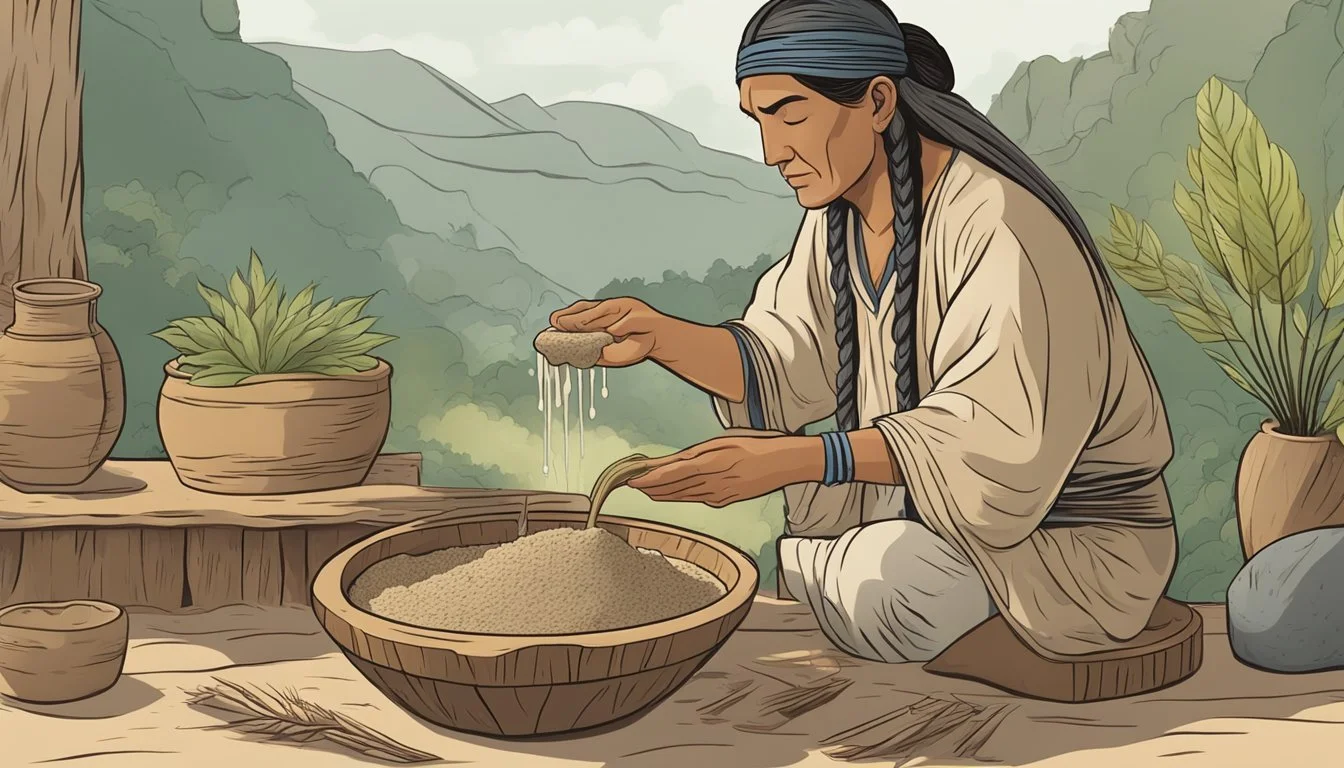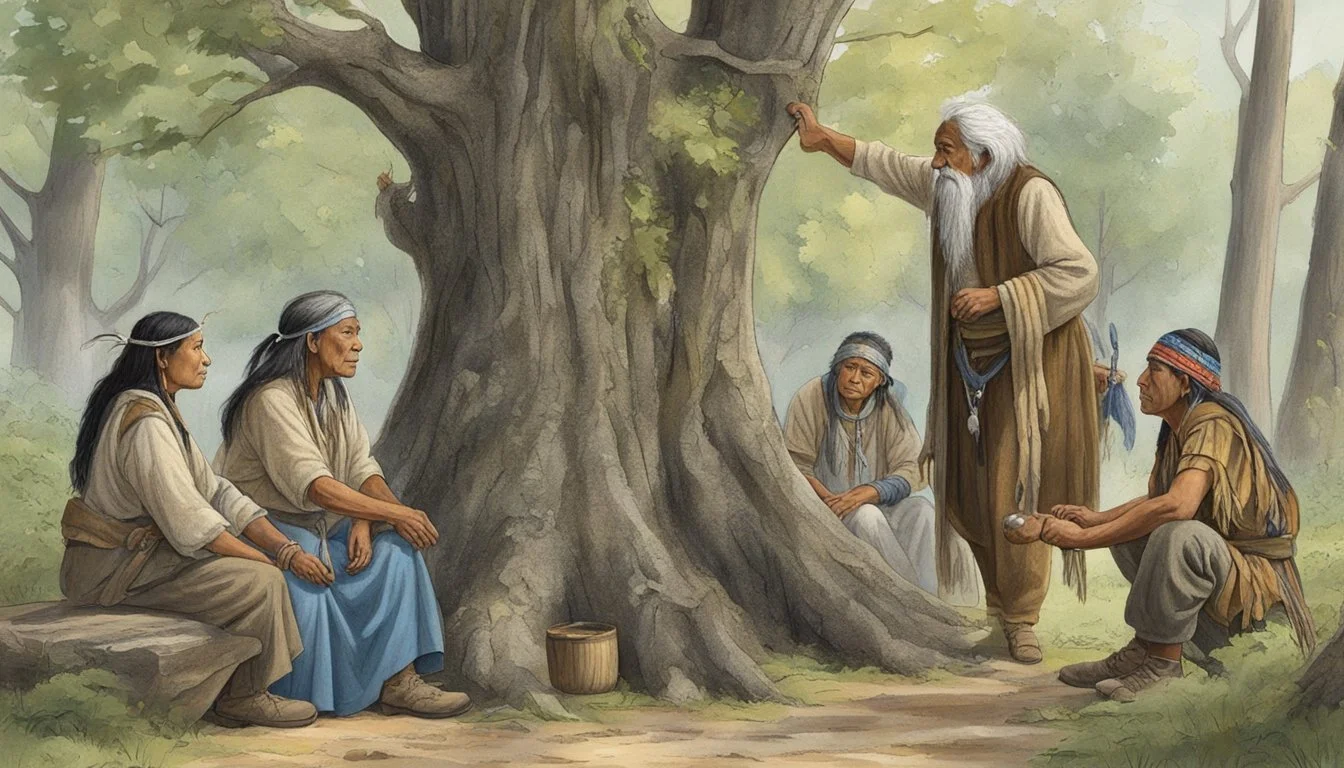The Traditional Uses of Slippery Elm in Native American Medicine
An Ethnobotanical Perspective
Slippery elm, scientifically known as Ulmus rubra, is a species native to North America that has been a staple in traditional Native American medicine for centuries. Recognized for its therapeutic properties, the inner bark of slippery elm has been utilized by various tribes to address a myriad of health issues. Its beneficial uses stem from the mucilage—a gel-like substance that becomes a slick gel when mixed with water, providing the 'slippery' part of its common name.
Native American healers traditionally employed slippery elm internally for conditions such as sore throats, coughs, and digestive problems. This was largely due to its soothing effect on mucous membranes. Externally, it was applied as a salve to heal wounds, boils, ulcers, burns, and for the reduction of skin inflammation. The versatility of slippery elm made it an invaluable component of traditional medicine, reflecting a deep understanding of the natural remedies available to indigenous peoples.
The comprehensive application of slippery elm by Native Americans demonstrates a sophisticated knowledge of botanical medicine that pre-dates contemporary medicinal practices. Despite its long history of use, modern research into the full range of benefits and properties of slippery elm is still evolving. However, the enduring reliance on this natural remedy underscores its significance within traditional medicine and its potential contributions to modern health and wellness.
Slippery Elm holds a revered place in Native American medicine, cherished for its traditional uses in promoting health and well-being. This remarkable herb has been an integral part of indigenous healing practices for its potential to soothe and support overall wellness. When combined with chia seeds and goldenseal, Slippery Elm offers a holistic approach to supporting health, reflecting its enduring appeal in ancient and modern wellness traditions.
Furthermore, the addition of frankincense and myrrh, black seed oil, and peppermint further complements the health-promoting potential of Slippery Elm, contributing to its reputation as a versatile and effective natural remedy. Additionally, the incorporation of maca root and aronia berries into wellness practices alongside Slippery Elm has expanded the spectrum of potential health benefits, underscoring the enduring appeal of this remarkable herb.
In conclusion, Slippery Elm continues to be celebrated for its traditional uses in Native American medicine, offering a natural solution for promoting well-being. Whether combined with chia seeds, goldenseal, frankincense and myrrh, black seed oil, peppermint, maca root, or aronia berries, Slippery Elm remains a symbol of health and vitality, embodying the rich heritage of natural health practices.
History and Botany of Slippery Elm
The Slippery Elm, also known scientifically as Ulmus rubra, holds a prominent place in the traditional medicinal practices of Native American cultures, distinguished by its unique botanical characteristics which have been valued over centuries.
Historical Significance in Native American Culture
Slippery Elm has been a cornerstone in Native American herbal medicine with its use dating back to the indigenous tribes of North America. It was valued for its ability to soothe and heal a variety of ailments. The inner bark, in particular, was utilized for medicinal purposes, including wound healing, treatment of sore throats, and digestive issues.
Wound Care: Applied as a poultice to heal cuts and burns.
Digestive Aid: Consumed as a tea or gruel to alleviate stomach problems.
Respiratory Relief: Used to treat coughs and sore throats.
These uses were not just practical but deeply integrated into the holistic understanding of health in various Native American tribes.
Botanical Profile of Ulmus Rubra
Slippery Elm is a member of the Ulmaceae family, characterized as a medium-sized tree that can be found predominantly in the temperate forests of North America. It is distinguished by its heart-shaped leaves and unique inner bark that becomes mucilaginous when moist.
Scientific Classification:
Kingdom: Plantae
Order: Rosales
Family: Ulmaceae
Genus: Ulmus
Species: U. rubra
Physical Description:
Leaves: Alternate, ovate with toothed margins, and hairy undersides.
Bark: Dark brown, deeply furrowed, and scaly.
Flowers: Small, reddish, in dense clusters.
Fruit: Samara, which is a winged seed.
The bark's mucilaginous property is key to its therapeutic applications and is harvested sustainably to protect the species from over-exploitation.
Phytochemistry
The inner bark of Slippery Elm is rich in bioactive compounds that contribute to its medicinal properties. These compounds include mucilage, a gel-like substance, as well as other elements like tannins that provide its therapeutic effects.
Key Constituents of the Inner Bark
The inner bark of Slippery Elm (Ulmus rubra) contains a variety of constituents that are vital to its pharmacological effects. These include:
Mucilage: A complex mixture of polysaccharides that forms a gel when mixed with water.
Tannins: Phenolic compounds that exhibit astringent properties.
Other bioactive components: These can include dietary fibers such as cellulose and lignin.
Mucilage and Its Therapeutic Properties
Mucilage is the primary active constituent in the inner bark of Slippery Elm that contributes to its demulcent effect. As a demulcent, the mucilage forms a soothing, protective layer over mucous membranes, which:
Provides relief from minor pain and inflammation.
Is useful in conditions such as sore throat or gastrointestinal inflammation.
The gel-like substance created by the mucilage also adds bulk to the stool and can aid in conditions like diarrhea, adhering to the traditional use of Slippery Elm in digestive health.
Medicinal Applications
Slippery elm has been esteemed for its healing properties, particularly for aiding digestive and respiratory issues, and soothing various skin conditions.
Slippery Elm for Digestive Issues
Slippery elm is rich in mucilage, a gel-like substance that coats and soothes the digestive tract. Traditionally, it has been used to treat gastrointestinal ailments such as diarrhea and ulcers. The mucilage is believed to ease inflammation in the gut, offering relief from discomfort and irritation.
Respiratory Relief and Throat Ailments
For respiratory conditions, slippery elm has been a go-to remedy. It has been used to alleviate sore throats and coughs by creating a soothing layer over the affected mucous membranes. This demulcent property provides temporary relief and is one of the reasons slippery elm was commonly used in medications for these ailments.
Skin Conditions and External Healing
Native Americans recognized slippery elm's potential for external healing. A salve made from the inner bark was applied to wounds, burns, boils, and skin inflammations. The mucilage not only soothes the skin but also promotes healing. It was a natural dressing for minor skin conditions and larger abrasions.
Therapeutic Preparation and Usage
Slippery elm bark has been utilized for its healing properties, particularly the mucilage it contains that turns into a gel-like substance when mixed with water. This section explores the various ways slippery elm has been prepared and used traditionally.
Teas and Lozenges for Internal Use
To harness the demulcent effects of slippery elm, Native Americans traditionally made tea by steeping the powdered inner bark in hot water. The resulting tea was consumed to soothe sore throats and digestive ailments. Lozenges were also formed from the slippery elm extract to provide a more convenient and portable option for treating throat irritation and coughs.
Poultices and Topical Application
For external healing, slippery elm was mixed with water to create a poultice. This paste was applied to the skin to aid in the healing of wounds, boils, ulcers, burns, and skin inflammation. The mucilage's soothing properties helped to calm irritation and promote recovery when used topically.
Dosage, Capsules, and Other Forms
Though traditional use did not involve precise measurements, the dosage in modern applications tends to be standardized, especially in manufactured forms like capsules. These capsules are taken according to specific guidelines for various conditions. Beyond teas and poultices, slippery elm is now available in several forms, including powders and extracts, allowing for versality in application and uniformity in dosing.
Safety, Precautions, and Research
When considering the use of slippery elm in traditional Native American medicine, one must pay careful attention to safety, potential side effects, and the specific precautions warranted by research findings. The current state of research provides a foundation for understanding these factors but also indicates areas in which further study is needed.
Side Effects and Contraindications
Side Effects: Most adults tolerate slippery elm well; however, due to its mucilaginous properties, it may sometimes cause minor gastrointestinal discomfort.
Pregnancy and Breastfeeding: Limited information is available on the safety of slippery elm during pregnancy and breastfeeding; thus, it is advisable for those who are pregnant or breastfeeding to use caution and consult a healthcare provider.
Interactions with Medication and Absorption
Medication Absorption: Slippery elm may interfere with the absorption of certain drugs. Therefore, individuals should take medications at least one hour before or two hours after consuming slippery elm.
Research Insights and Future Directions
Research on Health Benefits: Current research supports some traditional uses of slippery elm, but more comprehensive studies are required to substantiate its health benefits.
Future Directions: Further clinical trials are needed to establish efficacy and safety profiles for slippery elm, specifically regarding its long-term use and impact on liver enzymes and various health conditions.
Cultural and Ecological Considerations
The use of Slippery Elm (Ulmus rubra) in traditional Native American medicine is deeply interwoven with cultural respect for the environment and the sustainability of natural resources. This section explores the perspectives of Native Americans on the sustainable use of Slippery Elm and examines the environmental challenges this species faces, particularly from Dutch elm disease.
Native American Perspectives on Sustainability
Native American communities traditionally approach the harvesting of Slippery Elm with a strong ethic of sustainability, understanding the need to ensure the continued availability of this significant medicinal resource for future generations. They often employ specific techniques for sustainable harvesting that do not harm the trees, such as taking only small strips of the inner bark to allow the tree to heal and continue growing. The traditional practices underscore a relationship with nature that is characterized by stewardship and balance.
Key Species
Moose Elm: Also known as Slippery Elm.
Soft Elm: Another common name for Slippery Elm.
Rock Elm: A related Ulmus species but not typically used medicinally.
Environmental Impacts and Dutch Elm Disease
Dutch Elm Disease (DED), caused by an invasive fungal pathogen spread by elm bark beetles, poses a severe threat to Ulmus spp., including those varieties used by Native Americans for medicinal purposes such as the Slippery Elm. DED has devastated elm populations across North America, significantly reducing the availability of healthy trees from which to sustainably harvest bark.
Affected Wildlife
Beetles: Spread Dutch elm disease, impacting all Ulmus spp.
Native Birds: Rely on elm trees for habitat; their populations can be affected by the decline in elm populations.
Impacted Elm Varieties
Gray Elm: Another name for Slippery Elm, also susceptible to DED.
Orme (European Elm): Though not a North American species, it highlights the widespread impact of DED across multiple elm species.
Conservation Efforts
Active research is ongoing to develop disease-resistant Ulmus spp strains.
Efforts to combat the spread of DED include careful monitoring and removal of affected trees to prevent further spread.
Through these considerations, it becomes clear that the cultural significance of traditional medicine and the ecological challenges facing Slippery Elm are deeply connected. The health of the species is not only a matter of environmental concern but also of preserving indigenous practices and knowledge.








